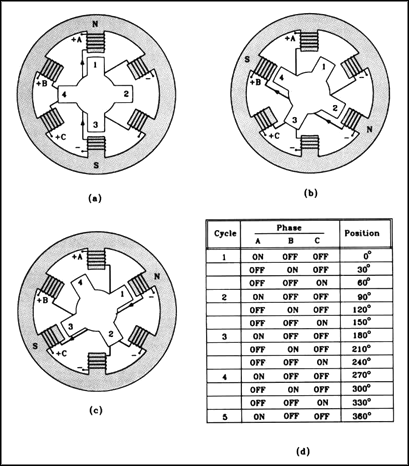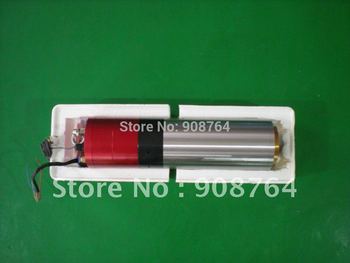Linear motion system:
The two main drive systems are either servo motors or stepper motors.
Therefore I will compare stepper motors with servo motors subjectively to attain the best type of motor for the application.
Stepper motors vs Servo Motors:
Stepper motors

http://zone.ni.com/cms/images/devzone/ph/81947a871576.gif
This diagram shows the stator and coil arrangement within a stepper motor. A stepper motor does at the name suggests and steps by a given amount. The diagram above shows a stepper motor with a single step consisting of 30 degrees. The stepper motors suitable for this application have many more stator and coils resulting in a single step angle of 1.8 degrees. The positioning of the rotor is relative to the coil current arrangement at that point in time. This can thus be manipulated to rotate the motor to the required position. This requires no feedback loop at the position will be dictated by the coil current arrangement.
However due to having no feed back loop if the torque supplied by the motor is less than is being resisted by whatever the motor is driving it will cause the motor to loose position. This could cause issues with part accuracy and the machine being damaged due to torque continuing to be applied despite the machine being stalled at the cutter tip.
Another issue with stepper motors is their speed torque characteristics.

http://www.anaheimautomation.com/images/stepper/torque/17Y402S%20Torque%20Curve%20%28400x293%29.png
The bottom of the graph shows the speed of the motor and the torque of the motor, the vertical axis on the left shows the maximum torque of the motor at that speed. As the speed of the motor increases the torque curve drops off dramatically. With a 200 step/rev motor on a 5mm pitch screw will result in a machine resolution of 0.025mm per step. At a cutting speed of 10 meters/minute this equals 400000 steps/min 6666 & 2/3 steps per second or 33 & 1/3 revolutions per second. This will result in minimal torque at cutting speeds.
Servo Motors
Servo motors are constructed in a very similar way to stepper motors, however they have many less stator poles and poles on the rotor its self. They are rotated in the same way however due to the huge angles between potential positions generated by the stator holes they require a closed loop feedback position. Between stator poles there is an infinitely variable number of positions. This position is controlled by the current supplied to varying stator poles. This allows very fine positioning where as a stepper motor is limited to stepped positions.

http://www.anaheimautomation.com/images/brushless/torquecurve/BLZ362S-24V-3500%20Torque%20Curve%20%28400x321%29.png
This graph shows the torque/speed characteristics of a servo motor. Although as speed increases the torque decreases the curve is much flatter across the rpm range in comparison to the stepper motor.
One benefit of the stepper motor over the servo motor is the cost, generally servo motors cost more.
https://www.damencnc.com/en/components/motors-and-drivers/steppermotor/197
This is a NEMA 23 2nm stepper motor at a cost of
€41.99
https://www.damencnc.com/en/components/motors-and-drivers/delta-ac-servo-motors/932
This is a servo motor that can ran at 2NM continuous load at a cost of
€400
Although stepper motors are certainly less expensive, the servo motors do have the ability to stop in the event of an issue and provide better speed torque characteristics. Thus Servo motors have been chosen as opposed to stepper motors.
Guide system:
Upon analysis of the three machines 3 linear guide systems were apparent.
Round rails
http://www.zappautomation.co.uk/mechanical-products/precision-round-rail-385/sfc25-precision-round-rail.html
Cost: £36/1000mm
Supported round rails
http://www.zappautomation.co.uk/mechanical-products/precision-supported-round-rail-386/tbr20-supported-roaund-rail-32343.html
Cost: £46.20/1000mm
Profile rails
http://www.zappautomation.co.uk/mechanical-products/isel-linear-guide-rail-systems-384/linear-guid-rail-systems/lfs-8-1-linear-guide-rails-31198.html
£82.31
Round rails without support will provide little support in suitable dimensions resulting in deflection values that will affect the accuracy of the machine. Supported round rails the carriage will rotate around the axis of the rail. This will result in them not being able to suitably transmit force into the support structure they will be bolted too. A profile rail system will provide suitable support however they are the highest cost item, despite this they will be chosen as the linear guide system.
Drive mechanisms
The two main drive mechanisms are ball screws and rack and pinion from analysis of the three commercial machines.
Ball screwsBall screws have a round profile cut in a pitch along the axis of the screw, ball bearings then run in in this profile. A nut with the same profile is used. The ball bearings are then placed within the two profiles and circulated throughout the ball screw. By loading two ball screws against each other its possible to eliminate the backlash within the machine. Ballscrews are also generally very smooth along the axis, this will therefore improve surface finish and accuracy over other drive mechanisms. However ball screws do have some short comings. These include:
Requirement for design to ensure ball screws don't become contaminated.
Precision alignment during assembly

http://valuablemechanisms.files.wordpress.com/2010/05/ball-screw.gif
Rack and pinionRack and pinion is constructed as the name suggests, by running a toothed pinion and a toothed rack its possible to convert rotary motion to linear motion. There are a few ways of eliminating backlash on the rack and pinion setup. One way is to force the pinion deeper into the rack, however, this results in excess load on the motor driving the pinion and increased wear on both the rack and pinion. Another way is to run another pinion on the rack and gently apply force in the opposing direction. However, this adds complexity to the design of the machine. Also due to the increased friction other other drive mechanisms they are inefficient.

http://img.directindustry.com/images_di/photo-g/racks-pinions-20096-2786531.jpg
http://www.cntmotion.com/before_you_buy.html
Construction
One of the machines used aluminum profile as the main material used within the construction of the machine, others are using steel and or cast iron as the main construction material.
There are four main criteria to consider when selecting a material for a machine such as this.
Tensile strength and compressive strength
Mass and frequency damping properties
Young modulus
Cost
As this machine is a one off machine and not a production machine, casting is not really a viable option on a one off due to the cost involved of creating tooling. Cast iron is also not readily available in sheet format for machining also much like steel it is a fairly heavy material.
Aluminum alloy is a fairly light material. Its also readily available and each to process. The machine will require all moving assemblies to be fairly light weight due to available and cost of motors. However, a structure could be created that is strong enough to withstand the forces from aluminum and transmits resonance to non moving components such as the base of the machine. The base of the machine will be made from steel as its easy to fabricate, cost effective and readily available.
Other aspects:
One of the machines has a dust extraction system, as this machine will mostly be used to machine MDF this would improve safety of use of this machine and improve the cutting operation due to less re cutting of machined material being left from the previous cutting operation or pass.
All machines seem to move the spindle and tool as opposed to the workpiece. This is to maximize the available work area within the footprint of the machine. However a fixed spindle style machine would increase strength and allow the frame to be much more substantial resulting in less resonance.
Due to the space constraints the moving spindle type machine will be required.


























